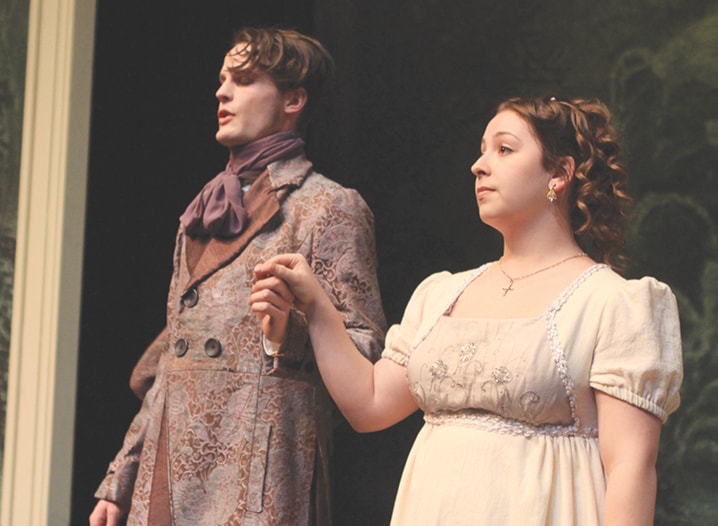Red Deer College’s Pride and Prejudice boasts a spectacular set, lavish costumes, a sparkling supporting cast and all the witty dialogue of Jane Austen’s beloved novel.
Austen might have called it a “tolerably” fine production — which in modern parlance would mean very satisfactory, indeed.
The Jon Jory adaptation that opened on Thursday at the Red Deer College Arts Centre actually had all the makings of a most excellent evening of theatre, save that a key ingredient was missing — the romantic chemistry between Elizabeth Bennet and Mr. Darcy.
RDC Theatre Studies students Nate Rehman and Kassidee Campbell took on the considerable challenge of playing two of the best known and loved characters in English literature. Everybody who has read the novel, or seen a film of it, has formed some kind of mental picture of what these characters should look and sound like.
The tall, dark Rehman seemed appropriately remote and taciturn as Darcy, an upper crust snob who makes a fatal first impression when refuses to dance at a party. As the handsome and haughty proprietor of Pemberley, Darcy goes on to disparage the available selection of female partners — including Elizabeth Bennet, who overhears him and holds a grudge.
In the novel, Mr. Darcy comes to regret his words after being charmed by the intelligence, humour and vitality of the second oldest Bennet daughter.
Campbell’s Elizabeth is not waifish, in the mould of some actresses who have played the role. While she brings out some of the character’s wit and charm, these qualities are mostly seen in the last half of the play. Campbell needs to try harder to convey from the outset the original spirit and vivaciousness that would draw a man of large fortune to a woman of modest means — especially when Elizabeth’s own family considers her no beauty.
This story’s entire premise hangs on this.
To get a sense of the fireworks that should be happening between Austen’s two unlikely lovers, the audience needs to see some of Mr. Darcy’s frost melt and Elizabeth’s inner conflict grow as she finds herself unaccountably attracted to someone she fears is not a very nice person.
Other than the need for more heat, Pride and Prejudice, as directed by Lynda Adams, has tons going for it — including some great staging and riotously funny supporting performances.
Brock Beal played the simpering Mr. Collins (with screwed-down hair-do) to hilarious effect — especially when paired against Richie Jackson’s long-suffering Mr. Bennet, who can’t stomach his clergyman cousin’s endless philosophizing.
Rina Pelletier portrayed inappropriate Mrs. Bennet with a voice that grated like nails on a chalkboard.
Pharaoh Seeley was a suitably angelic Jane Bennet, while Emily Seymour was the brainless Lydia. Robyn Jeffrey played youngest sister Kitty Bennet, and Emily Cupples produced early laughs as over-earnest Mary.
Michael Moore was the dashing rogue Wickham, Erin Pettifor and Damon Lutz played rich siblings Caroline and Mr. Bingley, and Katie Walker proved to be a formidable Lady Catherine de Bourgh.
Jory peppered his script with Austen’s pithy dialogue — such familiar exchanges as: Mr. Darcy: “My good opinion, once lost, is lost forever.” Elizabeth: “That is a failing indeed. But I cannot laugh at it.”
Or Mrs. Bennet: “You take delight in vexing me. You have no compassion on my poor nerves!’’ Mr. Bennet: “You mistake me, my dear. I have a high respect for your nerves. They are my old friends ... these 20 years.’’
The costumes (save for one oddly frumpy jacket worn by Elizabeth) were beautiful and fitting for the Regency era, in which the story is set.
Scenes in the play were often staged as tableaus, with various actors taking turns narrating portions of what’s happening directly to the audience.
Courtly country dances, choreographed by Tania Strader, stopped and started on cue, allowing for dialogue to happen between actors. Sometimes dancing carried on in the background as important scenes unfolded in front.
This all worked amazingly well against a fabulously painted pastoral backdrop designed by set designer Colin Winslow.
That breathtakingly bucolic backdrop was the real star of the show. It transported us to a simpler time and place — where love was, unfortunately, every bit as complicated as it is today.
Pride and Prejudice continues to Feb. 14.
lmichelin@www.reddeeradvocate.com
